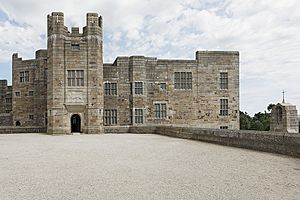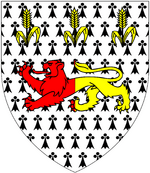Castle Drogo facts for kids
Quick facts for kids Castle Drogo |
|
|---|---|

"Drogo does not pretend to be a castle. It is a castle..."
|
|
| Type | House/castle |
| Location | Drewsteignton, Devon, England |
| Built | 1911–1930 |
| Built for | Julius Drewe |
| Architect | Edwin Lutyens |
| Governing body | National Trust |
|
Listed Building – Grade I
|
|
| Official name: Castle Drogo | |
| Designated | 20 February 1952 |
| Reference no. | 1106086 |
| Lua error in Module:Location_map at line 420: attempt to index field 'wikibase' (a nil value). | |
Castle Drogo is a unique country house and castle located near Drewsteignton, Devon, England. It was built between 1911 and 1930. This makes it the very last castle ever constructed in England.
The castle was built for Julius Drewe, a very successful businessman. He started a big chain of grocery stores called Home and Colonial Stores. Drewe believed the land where the castle stands belonged to his ancient family. He hired a famous architect, Edwin Lutyens, to design his dream castle. Even though Lutyens wasn't sure about building a new castle, he created one of his best works. Today, Castle Drogo is owned by the National Trust. It was the first 20th-century building the Trust took care of.
Contents
History of Castle Drogo
In 1910, Julius Drewe bought a large piece of land near Drewsteignton. He thought his family, the Drewes, had lived there a long time ago. Julius Drewe was born Drew, but he added the "e" to his name later.
Julius Drewe's Early Life and Business
When he was 18, Julius Drewe went to China to buy tea. He worked for his uncle's tea company. Later, he returned to England and opened his own tea store. In 1883, he and John Musker started the Home and Colonial Trading Association. This company sold teas and other groceries. By 1903, they had 500 stores across the country.
Building a Dream Castle
Around 1910, Julius Drewe decided to build a castle. He asked Edwin Lutyens, a well-known architect, to design it. Drewe was 54 years old but had lots of energy and money for his project. He planned to spend £50,000 on the castle and £10,000 on the garden.
Lutyens was a bit worried about building a castle. He wished Drewe wanted a "delicious loveable house" instead. However, on April 4, 1911, Julius Drewe's 55th birthday, the first stone of Castle Drogo was laid.
Challenges During Construction
Building the castle took many years. The First World War and a time of economic difficulty called the Great Depression caused many delays. Only a few skilled workers were used. One writer noted that "every stone was laid by two men alone."
Another sad reason for the slow progress was Julius Drewe's personal loss. His oldest son, Adrian, died in the war in 1917. This made Julius and his wife very sad. The overall building work was managed by John Coates Walker. Castle Drogo was finally finished in 1930. It was much smaller than Lutyens's first plans. Julius Drewe lived in the castle for about five years before he passed away in 1931.
Castle Drogo's Later Years
After Julius's death, his wife Frances and their son Basil lived at the castle. During World War II (1939–1945), Frances and her daughter Mary used the house to care for babies. These babies had lost their homes during the bombings in London.
In 1974, Julius's grandson, Anthony Drewe, and his son, Dr. Christopher Drewe, gave Castle Drogo to the National Trust. They also gave the Trust land and cottages nearby. This was a big gift, making Castle Drogo the first 20th-century property the National Trust owned.
The castle has been undergoing a big restoration project since February 2011. This work helps keep the castle in good condition for visitors. A new visitor center with a shop and café opened in 2009.
Castle Design and Features
Castle Drogo is famous for being the last castle built in England. The castle you see today is only about one-third of what architect Edwin Lutyens first planned. He had imagined a much larger building. Julius Drewe decided to make the walls extra thick for a more authentic feel. This made the building costs go up.
Architectural Style
The castle combines different styles. It has features from medieval and Tudor castles. But it also includes more modern, simple designs. Even though it looks like a strong, old castle, its defensive parts are just for show.
Castle Drogo was very modern for its time. It had electricity and elevators from the start. The power came from two turbines located on the river below. The castle is considered a Grade I listed building. This means it is a very important historic building.
Outside the Castle
The castle has a main part that is three stories tall. There is also a four-story section for the family and staff.
Inside the Castle
The main part of the castle has four main rooms for guests. These include the hall, the library, the dining room, and the drawing room.
Gardens of Castle Drogo
Castle Drogo has a beautiful formal garden. Edwin Lutyens designed the garden, and George Dillistone helped with the plants. The garden looks very different from the wild Dartmoor landscape around it.
In 1915, a famous garden designer named Gertrude Jekyll helped with the planting. She designed the plants for the path leading up to the castle. The gardens are known for their colorful rhododendrons and magnolias. They also have lovely herbaceous borders, a rose garden, and a shrub garden. There's even a circular grass tennis court, which is now used for croquet. The gardens are also listed as Grade II*, meaning they are very important historic gardens.
Climate at Castle Drogo
| Climate data for Castle Drogo, 1981–2010 normals | |||||||||||||
|---|---|---|---|---|---|---|---|---|---|---|---|---|---|
| Month | Jan | Feb | Mar | Apr | May | Jun | Jul | Aug | Sep | Oct | Nov | Dec | Year |
| Mean daily maximum °C (°F) | 7 (45) |
7 (45) |
9 (48) |
12 (54) |
15 (59) |
18 (64) |
20 (68) |
20 (68) |
17 (63) |
13 (55) |
10 (50) |
8 (46) |
13.0 (55.4) |
| Mean daily minimum °C (°F) | 1 (34) |
1 (34) |
2 (36) |
3 (37) |
6 (43) |
9 (48) |
11 (52) |
10 (50) |
8 (46) |
6 (43) |
3 (37) |
2 (36) |
5.2 (41.4) |
| Average precipitation mm (inches) | 151.8 (5.98) |
115.2 (4.54) |
112.5 (4.43) |
90.9 (3.58) |
95.2 (3.75) |
77.5 (3.05) |
84.7 (3.33) |
88.2 (3.47) |
101.8 (4.01) |
153.1 (6.03) |
148.4 (5.84) |
167.2 (6.58) |
1,386.5 (54.59) |
| Source: Chelsa Climate | |||||||||||||





